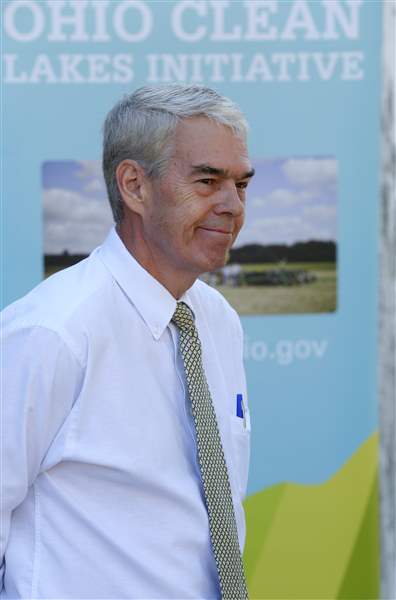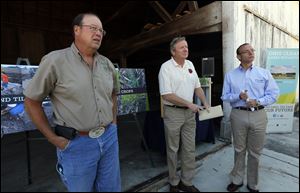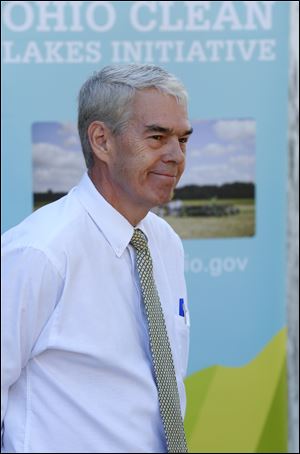
Stricter rules for agriculture debated
8/31/2014
Senator Randy Gardner (R) - District 2, listens to speakers during a press conference concerning new efforts to improve water quality in Lake Erie.
The Blade/Amy E. Voigt
Buy This Image

David Daniels, Ohio Department of Agriculture director, left, Jim Zehringer, ODNR director, and Craig Butler of the EPA, answer questions at a Wood County farm.
The algae-induced water crisis that rendered Toledo’s tap water undrinkable the first weekend of August has intensified the debate over how livestock facilities classified as Concentrated Animal Feeding Operations, or CAFOs, should be regulated.
The rise of CAFOs nationally is one of America’s biggest land-use issues.
As the demand for more U.S.-produced food grew to help meet greater needs of the world’s expanding population, agriculture became more consolidated. The trend was accentuated by decreases in available farmland as large housing subdivisions and big-box retail development became more popular in rural areas.
Economics changed, not only for food prices but also land and energy prices. Even many sons and daughters of traditional farming families — including those in northwest Ohio and southeast Michigan — say they must have more dairy cattle, hogs, and chickens than their parents did to make ends meet.
In many cases, major corporations have squeezed out family farmers. CAFOs have a lot more animals per acre than traditional farming, often thousands at each facility.
That results in massive manure pileups and accusations from critics — including smaller farming operations — that CAFOs are industrial agriculture and should be treated as such. In some cases, lagoons holding animal waste are believed to have spilled manure into ditches, rivers, and streams.

Senator Randy Gardner (R) - District 2, listens to speakers during a press conference concerning new efforts to improve water quality in Lake Erie.
The greatest concern, though, is how the manure is applied to area farm fields — if the fields are oversaturated by the animal waste at the wrong time. Or if it is spread on frozen fields in the winter, allowing it to flow directly into nearby ditches and streams.
Pat Nicholson, who spent decades in the sewage-sludge industry as founder of N-Viro International Corp., questions how concentrated manure becomes after it has broken down in lagoons for months.
“That’s been the key to manure use forever,” Mr. Nicholson said. “The key word is ‘soluble.’ If you put phosphorus on the land in a soluble [liquid manure] form, it all goes straight into the water.”
Ohio Rep. Mike Sheehy (D., Oregon) is one of several legislators who have proposed or announced plans for tighter CAFO rules.
Mr. Sheehy has introduced House Bill 611, legislation to ban winter application of manure. It’s a practice that many Great Lakes scientists, including those at Ohio Sea Grant and those with the U.S.-Canada International Joint Commission, want to end because manure doesn’t penetrate soil when it’s frozen. The IJC is a 105-year-old State Department-level commission that coordinates federal water policy issues common to both countries.
“We’re looking for low-hanging fruit. We’re looking for quick relief for the lake,” Sandy Bihn, Lake Erie Waterkeeper founder, said.
Ohio Department of Agriculture Director David Daniels said such a ban is not necessary because most manure-management plans required by the state do not allow the practice.
Mr. Daniels said he considers Ohio’s rules against CAFOs tough enough.
But critics such as Wood County farmers Vickie and Larry Askins of Cygnet, Ohio, claim loopholes have allowed such restrictions to be easily waived and that there isn’t enough auditing or enforcement of existing regulations.
The couple recently filed a lawsuit in U.S. District Court in Toledo challenging the state of Ohio’s 2000 decision to transfer environmental permitting of CAFOs from the Ohio Environmental Protection Agency to the Ohio Department of Agriculture. They and other opponents have likened that to the “fox watching the hen house,” because the state agriculture department also is in the business of promoting large farming operations.
Senate Bill 356, co-sponsored by Ohio Sen. Edna Brown (D., Toledo) and others, calls for manure to become part of Ohio’s new certification program for fertilizer applicators. Senate Bill 150, which set forth provisions, was criticized for excluding CAFOs, but it was passed and enacted into law.
One of SB 150’s key allies, Ohio Sen. Randy Gardner (R., Bowling Green) told The Blade following a recent event at a Perrysburg farm that he isn’t sure CAFOs deserve the heavier scrutiny they’re getting in response to the Toledo water crisis.
“Has there ever been a single CAFO that has directly impacted the Lake Erie watershed?” Mr. Gardner asked. “I don’t know. I’d like to see the evidence if there has been.”
Contact Tom Henry at: thenry@theblade.com, 419-724-6079, or via Twitter @ecowriterohio.